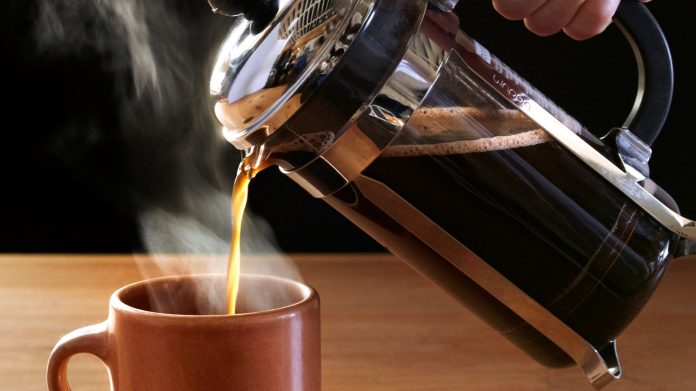Are you tired of weak, lackluster coffee that fails to wake you up in the morning? Look no further! In our latest article, we are going to share some secret tips and tricks for making an intense, full-bodied cup of coffee that will leave you energized and ready to conquer the day. From selecting the right beans to mastering the brewing process, we’ve got you covered. So grab your mug and get ready to take your coffee game to the next level!
Choosing the Right Beans
When it comes to brewing a truly exceptional cup of coffee, choosing the right beans is absolutely crucial. The flavor and strength of your coffee will largely depend on the type of beans you select. If you prefer a bold and intense flavor, dark roasts are the way to go. These beans are roasted for a longer period of time, resulting in a rich and robust flavor profile. On the other hand, if you prefer a smoother and more nuanced taste, opt for Arabica beans. Known for their complex flavors and pleasant acidity, Arabica beans are a popular choice among coffee enthusiasts.
To ensure the freshest and most flavorful coffee, it’s important to pay attention to the roast date of the beans you purchase. Freshly roasted beans will offer a much more intense and aromatic experience compared to older beans. Aim to select beans that have been roasted within the past two weeks for the best results. Focusing on these factors will set a strong foundation for brewing intense, full-bodied coffee.
Grinding for Extraction
After selecting the perfect beans, it’s time to move on to the grinding process. Investing in a burr grinder is highly recommended for achieving the best results. Unlike blade grinders, which can produce inconsistent grind sizes, burr grinders ensure a uniform grind that allows for optimal extraction. This is crucial for extracting the full range of flavors from your coffee grounds.
In addition to using a burr grinder, it is important to choose the right grind size for your brewing method. Different brewing methods require different grind sizes, as the size of the particles affects the rate of extraction and the resulting flavor of the coffee. For a stronger and more intense brew, a finer grind is typically recommended. However, be cautious not to grind too fine, as this can result in over-extraction and a bitter taste.
Grinding fresh is another essential aspect of brewing intense and full-bodied coffee. Coffee grounds start to lose their flavor soon after they are exposed to air. To preserve the freshness and quality of your coffee, grind your beans just before brewing. This will ensure that you are extracting the full range of flavors and aromas, resulting in a more intense and satisfying cup of coffee.
Water Quality Matters
Water quality is often overlooked when it comes to brewing coffee, but it plays a critical role in the final taste of your brew. Using filtered water is highly recommended to avoid any impurities or off-flavors that may be present in tap water. Filtered water will provide a clean and pure base for extracting the flavors from your coffee.
It’s also important to avoid using hard water when brewing coffee. Hard water contains high levels of minerals such as calcium and magnesium, which can negatively impact the taste of your brew and even clog your coffee equipment over time. Opt for soft or filtered water to ensure the best flavor extraction and to prolong the life of your brewing equipment.
Finding the optimal temperature for brewing is another essential factor in making intense and full-bodied coffee. The ideal water temperature for brewing coffee falls between 195°F and 205°F (90°C and 96°C). This temperature range allows for proper extraction of the coffee’s flavors without scorching the beans. Using a thermometer or an electric kettle with temperature control can help ensure that your water is at the optimal temperature for brewing.
Experimenting with Ratios
Finding the perfect coffee-to-water ratio is a key aspect of brewing intense and full-bodied coffee. Understanding the golden ratio, which is typically 1:15 (1 part coffee to 15 parts water), can serve as a helpful starting point. However, it’s important to remember that personal taste preferences may call for adjustments to this ratio.
Experimenting with different ratios can allow you to fine-tune your brewing process and achieve the desired balance of strength and flavor. Increasing the coffee-to-water ratio will result in a stronger and more intense brew, while decreasing the ratio will produce a milder flavor. Don’t be afraid to explore and adjust the ratio to find the perfect balance that suits your taste.
Exploring the full immersion method can also contribute to the intensity and body of your coffee. This brewing method involves immersing the coffee grounds in water for an extended period of time before straining. Full immersion methods like the French press or the AeroPress can produce a more robust and full-bodied cup of coffee compared to other brewing techniques.
Mastering Brewing Techniques
To truly achieve intense and full-bodied coffee, mastering various brewing techniques is essential. Exploring manual brewing methods can offer a deeper understanding of the brewing process and allow you to control each aspect to achieve the desired results. Methods such as pour-over, French press, and AeroPress provide a hands-on approach to coffee brewing and offer a greater level of control over the extraction process.
Pour-over brewing, in particular, is known for producing a clean and intense cup of coffee. This method involves pouring hot water over coffee grounds in a slow and controlled manner, allowing for optimal extraction. With practice, you can refine your pouring technique to achieve an even distribution of water and extract the maximum flavor from your coffee.
French press brewing is another popular method for making intense and full-bodied coffee. It involves steeping coarsely ground coffee in hot water and then pressing a plunger to separate the brewed coffee from the grounds. This method allows for a longer contact time between the water and the coffee, resulting in a stronger and more robust flavor.
Steeping for Intensity
Steeping time plays a crucial role in determining the intensity and concentration of your coffee. For a stronger brew, consider lengthening the steeping time. This allows for more extraction of flavor from the coffee grounds and creates a richer and more intense result. However, be cautious not to extend the steeping time too much, as it can lead to over-extraction and a bitter taste.
Utilizing pre-infusion can also contribute to the intensity and body of your coffee. Pre-infusion involves pouring a small amount of hot water over the coffee grounds and allowing them to bloom and release carbon dioxide before continuing with the brewing process. This can enhance the flavors and aromas of your coffee, resulting in a more intense and satisfying cup.
Understanding the bloom is also important when it comes to steeping coffee. The bloom refers to the release of carbon dioxide that occurs when hot water comes into contact with coffee grounds. This initial release of gas indicates that the coffee is fresh and can contribute to a more intense and flavorful brew. Allowing the bloom to fully develop before continuing with the brewing process can enhance the overall intensity and body of your coffee.
Controlling the Brew Time
Controlling the brew time is essential for achieving the desired strength and intensity in your coffee. Monitoring the extraction time is particularly important when using manual brewing methods. Over-extraction can result in a bitter and unpleasant taste, while under-extraction can lead to a weak and watery brew.
Timing the bloom is a crucial part of controlling the brew time. The bloom typically lasts around 30 seconds, but this can vary depending on the freshness and grind size of the coffee. Once the bloom is complete, continue pouring water slowly and steadily, ensuring that the total brew time aligns with your desired strength and flavor.
Adjusting for strength can be done by manipulating the brew time. If you prefer a stronger and more intense cup of coffee, consider extending the brew time slightly. Conversely, if you prefer a milder flavor, reducing the brew time can achieve a lighter and subtler taste. Experimentation and adjusting the brew time will allow you to perfect the strength and intensity of your coffee.
Perfecting the Pour
A properly executed pour is crucial for achieving an evenly extracted and full-bodied coffee. Pouring technique plays a significant role in ensuring an even distribution of water over the coffee grounds, which contributes to a balanced flavor and intensity.
To achieve an even distribution, pour the water in a slow and controlled manner, making sure to cover all the coffee grounds. Avoid pouring too rapidly or in a single spot, as this can result in uneven extraction and an imbalanced flavor profile. Instead, use a gentle circular motion or a back-and-forth motion to evenly saturate the coffee grounds and promote optimal extraction.
Avoiding channeling is another important aspect of perfecting the pour. Channeling occurs when water finds a path of least resistance through the coffee bed, causing uneven extraction and weaker flavors. To prevent this, pour the water in a steady and controlled manner, ensuring that all areas of the coffee bed are evenly saturated. This will result in a more even and consistent extraction, leading to a more intense and flavorful cup of coffee.
Stirring the coffee during the brewing process can also contribute to consistency and intensity. Gently stirring the coffee bed after pouring the water can help break up any clumps or uneven distribution of water, allowing for better extraction and a more uniform flavor throughout the brew. However, be cautious not to stir aggressively, as this can disturb the bed of coffee grounds and lead to over-extraction.
Experimenting with Temperature
Temperature plays a vital role in extracting the desired flavors and intensity from your coffee. Adjusting the brew temperature can help fine-tune the flavor profile and achieve the desired strength.
Experimenting with brew temperature can be done by adjusting the water temperature used for brewing. While the ideal temperature range is generally between 195°F and 205°F (90°C and 96°C), personal preferences may vary. If you prefer a bolder and more intense flavor, try increasing the brew temperature slightly. Conversely, if you prefer a milder flavor, lowering the brew temperature can achieve a smoother and lighter taste.
Exploring cold brew is another way to experiment with temperature and achieve a different flavor profile. Cold brew involves steeping coffee grounds in cold or room temperature water for an extended period of time. This method creates a smooth and less acidic coffee with a unique intensity. The lower temperature used in cold brew extraction results in a different flavor profile compared to traditional hot brewing methods.
Utilizing the siphon method is another way to experiment with temperature while brewing coffee. This method uses a combination of vapor pressure and vacuum suction to extract the flavors from coffee grounds. By adjusting the temperature and the brewing time, you can manipulate the flavor profile and intensity of your coffee for a truly unique and intense experience.
Enhancing Flavor with Additions
Adding spices is a great way to enhance the flavor and intensity of your coffee. Experimenting with spices such as cinnamon, cardamom, or nutmeg can bring a new level of complexity and depth to your brew. Sprinkling a small amount of your desired spice into your coffee grounds before brewing allows the flavors to infuse and create a more intense and aromatic cup of coffee.
Trying nut milk is another way to enhance the flavor of your coffee without overpowering it. Nut milks such as almond milk or oat milk can add creaminess and a subtle nutty flavor to your coffee. Experiment with different types and brands of nut milk to find the one that complements your coffee and adds a touch of intensity to each sip.
Utilizing syrups and sweeteners is a popular way to enhance the flavor of coffee and add sweetness. Experimenting with different syrups, such as vanilla or caramel, can bring a new level of intensity and complexity to your brew. Additionally, using natural sweeteners like honey or maple syrup can add depth and richness to your coffee without overpowering the flavor.
In conclusion, making intense and full-bodied coffee requires attention to detail and experimentation. Choosing the right beans, grinding fresh, using filtered water, exploring different ratios, mastering brewing techniques, controlling the brew time, perfecting the pour, experimenting with temperature, and enhancing the flavor with additions are all important aspects to consider. By following these tips and techniques, you can unlock the full potential of your coffee and enjoy a truly intense and satisfying cup every time.





































